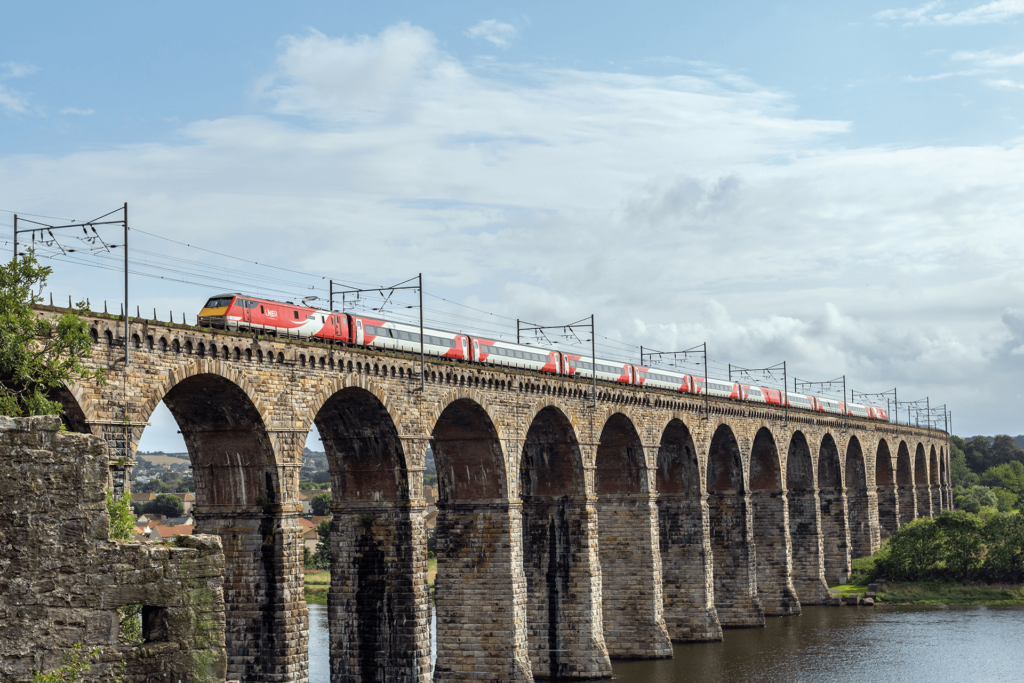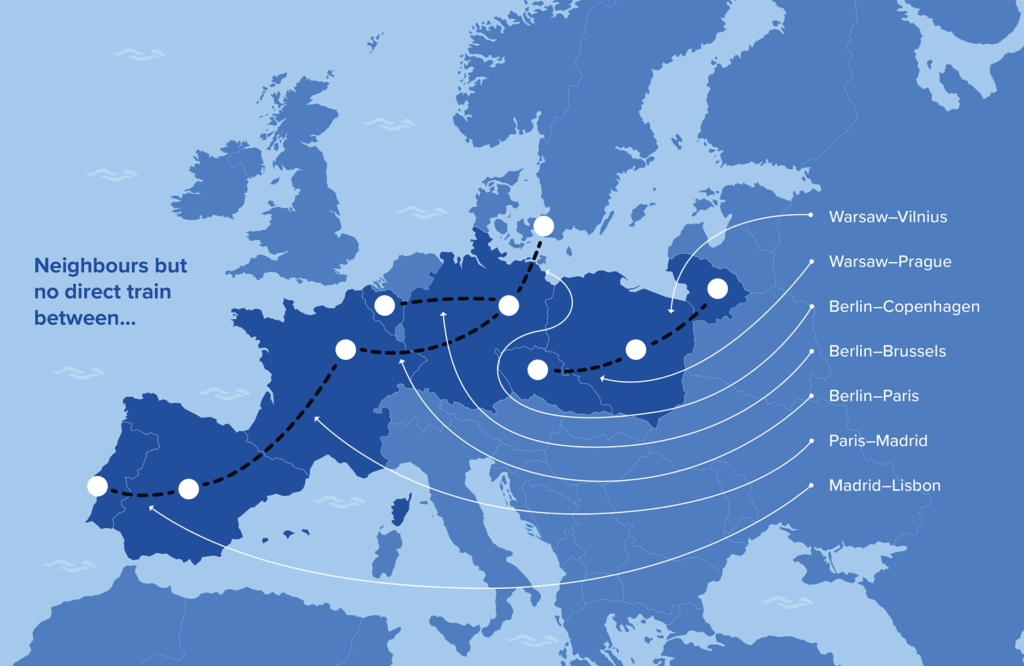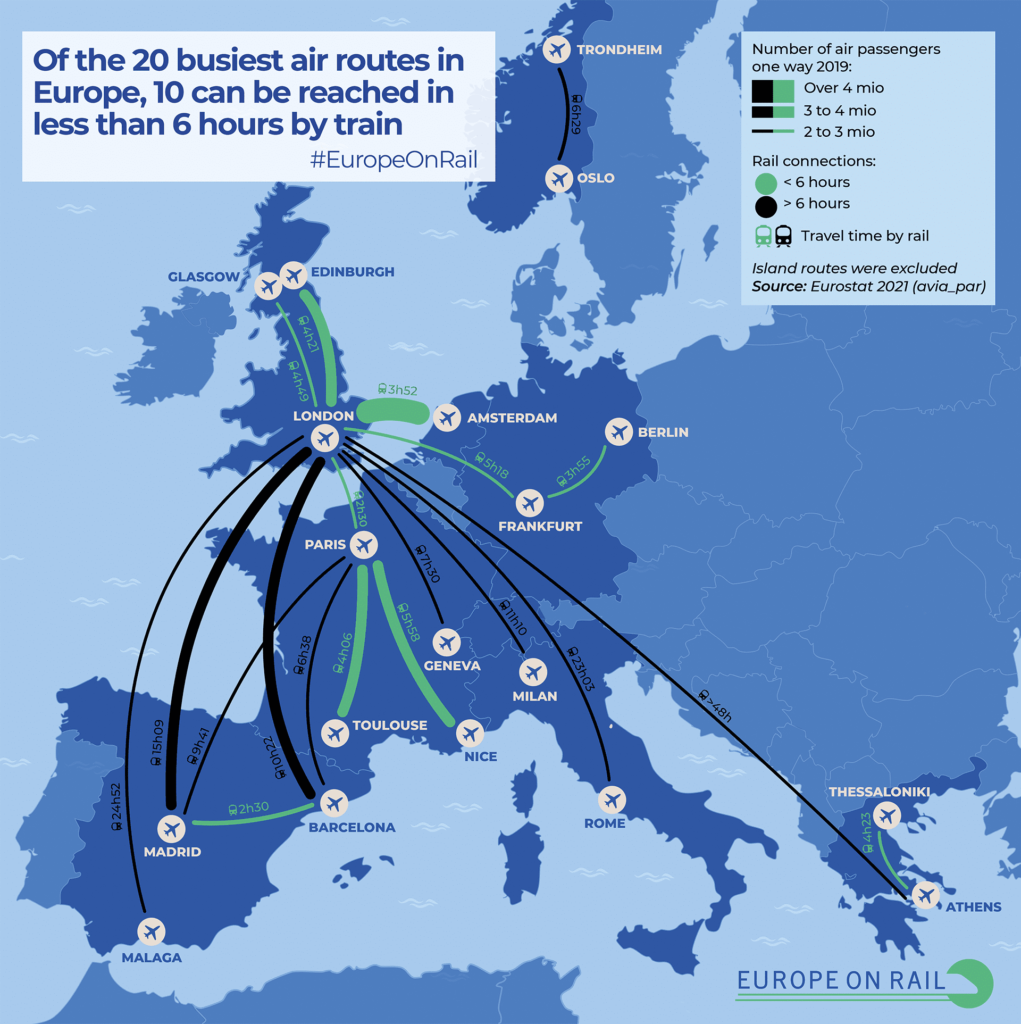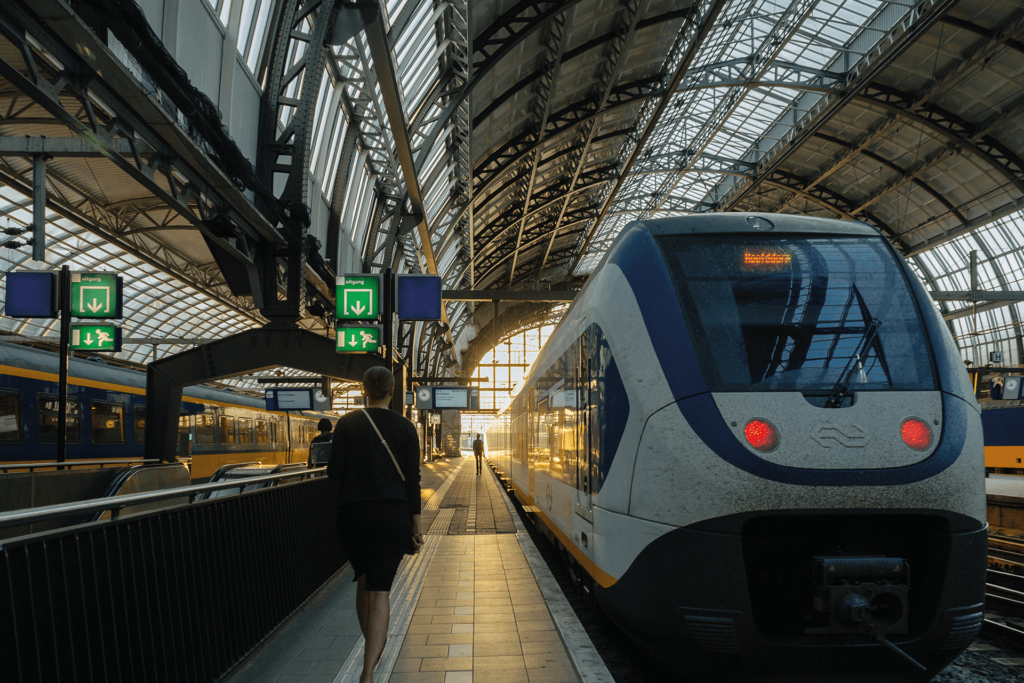Hop on the Train: A Rail Renaissance for Europe
How the 2021 European Year of Rail supports the European Green Deal for a more sustainable recovery.
The EU has set itself the target to become climate neutral by 2050 and making mobility more sustainable is necessary for reaching this target. Rail could therefore play a key role in the future transport system because it is clean, safe and reliable, and it could also become a symbol for the European Green Deal. Europe needs to become more climate friendly, and Europe needs to grow closer together. A strengthened European rail system has the potential to (1) reduce transport emissions by creating alternative options to road transport and aviation, (2) better connect people and businesses in Europe, and (3) give a green boost to the European economy post COVID-19.
Rail can help the EU to achieve its climate targets
Rail is the cleanest mode of transport. A flight from Paris to Berlin causes at least six times the CO2 emissions of a train journey. Counting the non-CO2 impacts of aviation, the flight is responsible for 18 times the climate impact of a rail trip. With further electrification and decarbonization of power generation, the carbon emissions of rail could be reduced to close to zero. Intra-European flights on distances less than 1,000 km are estimated to cause 28 MtCO2 every year, without counting the non-CO2 impacts.
Seventeen of the 20 most frequented air routes in Europe are for distances less than 700 km. In theory, almost all of these journeys could be shifted to rail. The better European cities are connected by rail, the easier it is to move transport away from high-polluting transport modes such as aviation and cars. The more attractive and easy-to use rail services are, the more likely it is that people will want to switch.

Rail connects people, cities and countries
In contrast to aviation, rail not only services highly frequented core routes but also has a network that reaches remote regions. This network was much denser 50 years ago, both within countries and in border regions. While many connections are not in use anymore because of massive divestment from rail, many could easily be reinstalled. A network of fast long-distance connections combined with dense regional services could make Europeans feel more connected to and part of the EU.
Rail can be a driver for European recovery post-COVID-19
The rail sector employs more than 2.3 million people (directly and indirectly) and creates a gross value added of €143 billion, of which €66 billion is created directly by the sector. This is larger than the gross value added of air transport. The EU rail supply industry accounts for around 20% of the global market. Rail infrastructure investments usually need more time but add to mid-term stability and growth expectations in the construction sector. Some rail infrastructure modernization projects could be realized rapidly, -for example track switches, bypasses, and European Rail Traffic Management System (ERTMS). The investments needed for the realization of the Trans-European Transport (TEN-T) core network, for example, is estimated to create €4.5 trillion cumulated GDP and 13 million job-years EU-wide.
European Year of Rail, an opportunity to boost European rail services
While many actors are praising railways, the European rail system is currently not in the best shape to take a central role in transport systems. In almost all EU member states, the importance of rail has declined over the last decades due to a heavy focus on road and aviation.
Rail accounts for only 8% of passenger transport, and international rail services in particular are not sufficiently developed. Of the 365 cross-border rail links that once existed, 149 were non-operational in 2018, and today not even all European capital cities are linked by direct rail services. The rail system in the EU is currently not more than a patchwork of national systems, with no comprehensive European strategy. In the European Year of Rail 2021, the EU and national governments need to seize the opportunity to boost European rail services. This is an excellent moment for initiating a rail renaissance because: (1) COVID-19 has reshuffled transport systems and travelling habits; (2) with the European Green Deal, the EU economy is on the brink of a new era; and (3) there is strong political support for rail from actors across the board.
The options for improving international rail are right in front of us. EU institutions and players tend to focus on infrastructure development, but this is expensive and time consuming. Also, rail infrastructure projects are often not matched with measures to simultaneously improve service quality to make efficient use of the new infrastructure. There are low-hanging fruits available to the EU which could boost international rail services immediately, without the need for large scale investments.

3 priorities for a Rail Renaissance in Europe
Priority 1: Launch new direct international services, day and night, on existing infrastructure
International rail services between major European cities offer a large untapped potential. Most rail services stop at a border or end just on the other side. Travelers often need to change trains several times to get from one capital to the other which means additional stress and waiting time for the traveler. The few direct services often stop too many times along the way and wait too often at major traffic nodes for track capacity. Direct trains between all European major cities of neighboring countries should be an absolute minimum, also other metropolitan areas should be connected with direct and frequent services.
Furthermore, long-distance trains should connect well with regional rail services, to establish a dense and attractive network. Connecting long-distance trains to regional rail services does not always require new high-speed infrastructure. Much of the infrastructure is already there, especially in western Europe, but is not utilized to its full potential. A European Commission report found that of 202 operational cross-border rail links, only 57 were fully exploited in 2017. In many cases more efficient use of existing high-speed or even conventional infrastructure and better coordination of timetables would be sufficient. A well-coordinated timetable could also integrate regional and longdistance trains and improve connectivity in Europe.
How can the EU launch new international rail services in the short term?
- Get started: Agree on one or two corridors to start with (e.g. Warsaw-Berlin-Brussels-Paris or Amsterdam-Paris-Barcelona).
- Corridor coordination: Task the European Railway Agency (ERA) with coordinating rail services on these corridors to create a one-stop shop for train operators. The agency could provide information on which rolling stock is required, and the frequency and speed of the services. It could facilitate coordination between infrastructure managers to ensure that services get the required track slots for fast and smooth journeys.
- Start-up support: Determine those sections of the corridor that the service can run on a commercial basis and those where it needs subsidies (at least to get started); start-up support should be tied to the condition that low-price tickets are available to make the service accessible to price-sensitive passengers.
- Vision: Agree on a comprehensive network of European day and night trains, with trains crossing external EU borders into the neighborhood (especially to the UK, Western Balkans, Turkey, Ukraine, Belarus and Russia).

Priority 2: Make booking of international services attractive and convenient
Booking international flights is very easy but buying international rail tickets is the opposite. Passengers cannot easily find and compare all available connections and prices and bear the risk of delays on the way. That needs to change: travelling by rail needs to become at least as easy as travelling by plane. Consumers should be able to book rail tickets for any connection in the EU via one-stop shops. Technical solutions for integrating information from different train providers are available. Independent online ticket vendors like Trainline, Omio, etc. try to assemble tickets from different operators, but their websites do not yet show all available rail connections and ticket offers. This is because rail operators are reluctant to share all the necessary data with other operators or with independent ticket vendors.

To make booking of international services more attractive and convenient the EU needs to require rail operators to share all necessary data for easy booking of international rail trips. Data such as platform numbers and changes, real-time delays and cancellations or predicted arrival time is critical for a seamless journey and for passengers to be able to find alternative connections in case of disruptions. Moreover, the EU needs to establish a comprehensive multimodal legal framework for booking, ticketing and payment services, making access to static and dynamic data mandatory, require rail operators to share data via an open Application Programming Interface (API), and allow ticket vendors to assemble their own discount and promotion packages to compete in an open ticketing market. And finally, the EU needs to establish rules to guarantee that international rail passengers arrive at their final destination and can hop on the next train in case of missed train connections. Rail passengers often need to buy individual tickets from different rail operators for a multi-leg journey-and under current rules passengers bear the risk if a connection is missed. Rail operators are currently not obliged to sell so-called ‘through tickets’, that is, one ticket contract for multi-leg journey with a guarantee to arrive at the final destination.
Priority 3: Invest in cross-border infrastructure connections and key corridors
EU funding (cohesion funding, Connecting Europe Facility, and the Recovery and Resilience Facility) makes up an important share of overall transport infrastructure funding, especially in the new member states. Yet, in the past, EU transport funding has not always been used wisely. Too much funding went into road and airports, and too little into rail. Too much money also goes into mega-projects with exploding costs and long delays. The European Court of Auditors cautioned, in 2018, that projects were often chosen based on political decisions and not on thorough cost-benefit analyses. The evaluated high-speed projects took 16 years on average, cost on average €25 million per track km, but often do not deliver on expectations: average speeds rarely reach 200 km/h, and only few lines transported more than nine million passengers per year (the benchmark for a successful high-speed line).

In contrast, small-scale interventions with greater European potential are often not implemented. This can be electrification, constructing a second track or bypasses to increase capacity and speed, or closing smaller missing links on the border. The European Court of Auditors also noted a lack of coordination of cross-border infrastructure projects. Member states take a national perspective and do not prioritize closing cross-border gaps.
The EU should ensure that EU funding: (1) Supports modal shift towards rail: In the negotiations of the Operational Programmes for Cohesion funding, the European Commission should ensure that more budget goes to rail than to road, and no new roads are financed in the old member states, as they already have a sufficiently dense road network. (2) Prioritizes rail projects essential for intra-European rail services: Connecting Europe Facility (CEF) funding should only go into projects that are key to cross-border connectivity (e.g. for key corridors), and should focus more on low-hanging fruits than on new mega-projects. Such interventions should be based on sound cost-benefit analysis. (3) Promotes infrastructure interventions which are accompanied by transformative measures: When accessing EU rail infrastructure funding, member states should be required to present accompanying policy measures which ensure that the infrastructure is used efficiently.
The rail necessity
An enhanced European rail system would significantly contribute to the EU’s target to become climate neutral by 2050 – at the latest. Europe needs a more attractive and connected rail system to offer an alternative to flights, reduce transport emissions and give a green boost to the economy.
Disclaimer: This article summarizes the key ideas of the report “Hop on the Train: A Rail Renaissance for Europe. How the 2021 European Year of Rail can support the European Green Deal and a sustainable recovery.” The report was elaborated under the Europe on Rail initiative, which aims to build support for a ‘Rail Renaissance’ in Europe, with a focus on cross-border passenger rail transport.